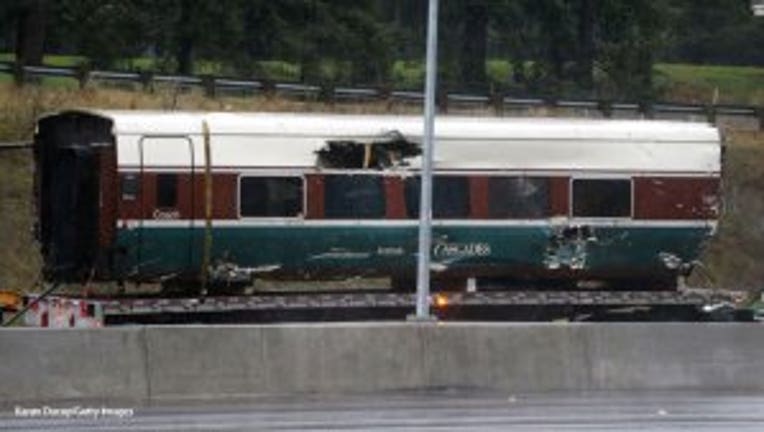Expert: New route may have distracted engineer before crash

DUPONT, WA - DECEMBER 19: Emergency crews continue lift a train car off the bridge after an Amtrak train that derailed onto Interstate 5 the previous day killing several passengers and injuring dozens more, on December 19, 2017 in Dupont, Washington.
SEATTLE — Experts say it's possible the engineer on an Amtrak train that derailed as it hurtled into a curve at more than twice the speed limit was distracted for an extended period of time before the train plunged off an overpass and onto a busy interstate, a key factor in the investigation.
Authorities worked Wednesday to reopen that vital highway ahead of the holiday travel rush as federal investigators focused on whether the engineer's attention was diverted by a second person in the cab, or by something else.
Three men were killed Monday south of Seattle when the train barreled into a 30 mph zone at 80 mph. Southbound lanes of Interstate 5 near DuPont have been closed at the accident ever since.
A conductor in training who was familiarizing himself with the new route was in the locomotive with the engineer at the time. A federal official who was not authorized to discuss the matter publicly and spoke on condition of anonymity said authorities want to know whether the engineer lost "situational awareness" — didn't realize where he was.
Rail-safety experts say that while it is fairly common to have two people in a cab, investigators will look into whether that may have distracted the engineer.
"What interactions were the conductor and the engineer having and did that distract the engineer from his focus on where they were on the route?" said Keith Millhouse, a rail-safety consultant who was former board chairman of Metrolink, Southern California's commuter rail system.
Millhouse said the two could have been having discussions that caused the engineer to not realize where he was on the route.
"My guess is there were probably distractions not only immediately prior to the accident but in the minutes leading up the accident and that's where the focus gets lost," he said.
Investigators had not yet interviewed the train engineer and other crew members — all of whom were hospitalized — as of Wednesday morning, a National Transportation Safety Board spokesman said. Experts say investigators will want to talk to them as soon as possible while the event is still fresh in their memory.
NTSB board member Bella Dinh-Zarr said Tuesday that they were in the early stage of the investigation, and investigators won't determine a probable cause while on scene. She said distraction is one of the most looked at priorities, and investigators will be looking at cellphone records of all employees.
Dinh-Zarr also said the engineer did not manually activate the emergency brake, which went off automatically when the train derailed.
"This is a situation where the engineer should have been starting the braking application probably a minute before they reached that curve," said Allan Zarembski, a civil engineering professor who directs the rail engineering and safety program at the University of Delaware.
"It suggests strongly that the engineer was distracted for a fairly extended point of view," he said. The information so far "seems to suggest that there was an operator issue here," he said.
In some previous wrecks, train operators were found to have been seriously fatigued or distracted by a cellphone or something else.
On Wednesday, crews removed a train locomotive from the crash site and were cleaning up debris and repairing the road in order to reopen I-5 to traffic. The wreck closed the southbound lanes of I-5 south of Tacoma, a stretch that typically sees about 60,000 cars a day.
Authorities said they'd reopen the freeway lanes as soon as possible.
The train, with 85 passengers and crew members, was making the inaugural run along a fast, new 15-mile bypass route.
Authorities on Wednesday identified the third victim in the crash as Benjamin Gran, 40, of Auburn, Washington.
In an accident with strong similarities, an Amtrak train traveling at twice the 50 mph (80 kph) speed limit ran off the rails along a sharp curve in Philadelphia in 2015, killing eight people. Investigators concluded the engineer was distracted by reports over the radio of another train getting hit by a rock.
On Wednesday, a judge told prosecutors she will review the case and set a hearing for February where prosecutors may have the chance to argue that the engineer should be held criminally accountable for the derailment.
A different judge in September threw out involuntary manslaughter and other charges after finding evidence pointed to an accident.
Amtrak agreed to pay $265 million to settle claims filed by the victims and their families. It has also installed positive train control on its entire track between Boston and Washington.

